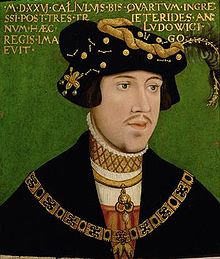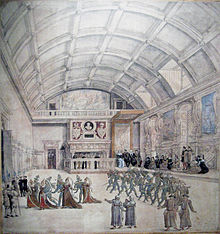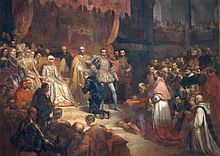- Mary of Hungary (governor of the Netherlands)
-
For her niece and namesake, who was also Queen of Hungary, see Maria of Austria, Holy Roman Empress.
Mary of Austria 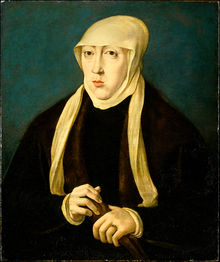
A portrait of Mary by Jan Cornelisz Vermeyen Queen consort of Hungary and Bohemia Tenure 22 July 1515 – 29 August 1526 Coronation 11 December 1521 (Hungary)
1 June 1522 (Bohemia)Governor of the Habsburg Netherlands Tenure January 1531 – October 1555 Spouse Louis II of Hungary House House of Habsburg Father Philip I of Castile Mother Joanna of Castile Born 15 September 1505
BrusselsDied 18 October 1558 (aged 53)
CigalesBurial El Escorial Religion Christianity
(Roman Catholicism)[note 1]Mary of Austria (15 September 1505 – 18 October 1558), also known as Mary of Hungary, was queen consort of Hungary and Bohemia[note 2] as the wife of King Louis II, and she was later Governor of the Habsburg Netherlands.
The daughter of Queen Joanna of Castile and King Philip I of Castile, Mary married King Louis II of Hungary and Bohemia in 1515. Their marriage was happy but short and childless. Upon her husband's death following the Battle of Mohács in 1526, Mary governed Hungary as regent in the name of the new king, her brother, Ferdinand I.
In 1531, Mary was asked by her eldest brother, Emperor Charles V, to assume the governance of the Netherlands and guardianship over their nieces, Dorothea and Christina of Denmark, upon the death of their aunt Margaret. As governor of the Netherlands, Mary faced riots and a difficult relationship with the Emperor. Throughout her tenure she continuously attempted to ensure peace between the Emperor and the King of France. Although she never enjoyed governing and asked for permission to resign several times, the Queen succeeded in creating a unity between the provinces, as well as in securing for them a measure of independence from both France and the Holy Roman Empire.[1] After her final resignation, the frail Queen moved to Castile, where she died.
Having inherited the Habsburg lip and not very feminine looks, Mary was not considered physically attractive. Her portraits, letters, and comments by her contemporaries do not assign her the easy Burgundian charm possessed by her grandmother, Duchess Mary of Burgundy, and her aunt Margaret. Nevertheless, she proved to be a determined and skilful politician, as well as an enthusiastic patron of literature, music, and hunting.[2]
Contents
Early life
Born in Brussels on 15 September 1505, between ten and eleven in the morning, Archduchess Mary of Austria was the fifth and last child of King Philip I and Queen Joanna of Castile. Her birth was very difficult; the Queen's life was in danger and it took her a month to recover. On 20 September, she was baptized by Nicolas Le Ruistre, Bishop of Arras, and named after her paternal grandmother, Mary of Burgundy (died 1482). Her godfather was her paternal grandfather, Holy Roman Emperor Maximilian I.[3]
On 17 March 1506, Emperor Maximilian promised to marry her to the first son born to King Vladislaus II of Hungary. At the same time, the two monarchs decided that a brother of Mary would marry Vladislaus' daughter Anne. Three months later, Vladislaus' wife, Anne of Foix-Candale, gave birth to a son, Louis Jagiellon. Queen Anne died in childbirth and the royal physicians made great efforts to keep the sickly Louis alive.[4]
After the death of Mary's father in September 1506, her mother's mental health began to deteriorate. Mary, along with her brother, Archduke Charles, and her sisters, Archduchesses Eleanor and Isabella, was put into care of her paternal aunt, Archduchess Margaret, while two other siblings, Archduke Ferdinand and posthumously-born Archduchess Catherine, remained in Castile. Mary, Isabella, and Eleanor were educated together at their aunt's court in Mechelen. Their music teacher was Henry Bredemers.[2][5][6]
Queen of Hungary and Bohemia
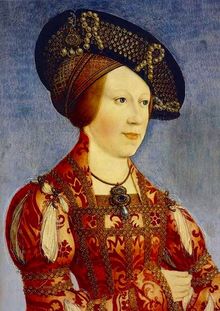 Portrait of the Queen by Hans Maler zu Schwaz painted in Innssbruck around 1520
Portrait of the Queen by Hans Maler zu Schwaz painted in Innssbruck around 1520
Mary was summoned to the court of her grandfather Maximilian in 1514.[5] On 22 July 1515, Mary and Louis were married in St. Stephen's Cathedral, Vienna. At the same time, Louis' sister Anne was betrothed to an as yet unspecified brother of Mary, with Emperor Maximilian acting as proxy.[4] Due to their age, it was decided that the newly married couple would not live together for a few more years.[4][5] Anne eventually married Mary's brother Ferdinand and came to Vienna, where the double sisters-in-law were educated together until 1516. That year, Mary's father-in-law died, making Louis and Mary king and queen of Hungary and Bohemia. Mary moved to Innsbruck, where she was educated until 1521. Maximilian encouraged her interest in hunting, while childhood lessons prompted an interest in music. This passion would later be demonstrated during her tenure as governor of the Netherlands.[5]
Life with Louis
Mary travelled to Hungary in June 1521, three years after Emperor Maximilian's death. She was anointed and crowned Queen of Hungary by Simon Erdödy, Bishop of Zagreb, in Székesfehérvár on 11 December 1521. The queen's coronation was followed by brilliant festivities. The royal marriage was blessed on 13 January 1522 in Buda. Mary's anointment and coronation as Queen of Bohemia took place on 1 June 1522.[5][7]
Mary and Louis fell in love when they were reunited in Buda.[4] At first, Queen Mary had no influence over politics of Hungary and Bohemia because of her youth. Her court was replete with Germans and Dutch, who formed a base for the interests of the House of Habsburg. By 1524 Mary negotiated significant authority and influence for herself. In 1525, she took control over one powerful political faction and neutralised another.[8] Austria's ambassador, Andrea de Borgo, was appointed by the Queen herself.[5]
During her tenure as queen of Hungary, Mary attracted the interest of Martin Luther, who dedicated four psalms to her in 1526. Despite her brother Ferdinand's strong disapproval, Luther's teachings held great appeal for Mary during her marriage and even more for her sister Isabella and her brother-in-law King Christian II of Denmark. Mary turned away from his teachings mostly because of pressure from Ferdinand. Her trusted court preacher, Johann Henckel, is also considered responsible for Mary's return to orthodox Roman Catholicism. The return was lukewarm,[9] but historian Helmut Georg Koenigsberger considers Mary's reputation for sympathy with Lutheranism "much-exaggerated".[2]
Louis and Mary spent their free time riding and hunting in the open country near the palace. They tried unsuccessfully to mobilize the Hungarian nobility against an imminent Ottoman invasion. Louis had inherited the crown of a country whose noblemen were fighting among themselves and against the peasantry.Hungary was deeply divided when, by the end of 1525, it became clear that the Ottoman Sultan Suleiman I was planning to invade.[4]
Ottoman invasion
On 29 August 1526, Suleiman and his army broke through Hungary's southern defences. Louis and his entire government marched out with a small army of 20,000 men. The Battle of Mohács was over in less than two hours, with the entire Hungarian army virtually annihilated. Louis tried to flee the site of the battle but slipped from his frightened horse and drowned. Mary would mourn him for the rest of her life.[9]
Hungary was divided into three parts: Ottoman Hungary - a part of the Ottoman Empire, Royal Hungary - ruled by Mary's brother Ferdinand, and Eastern Hungarian Kingdom - ruled by John Zapolya. Ferdinand was elected King of Bohemia. Mary took a vow to never remarry and always wore the heart-shaped medallion worn by her husband in the fatal Battle of Mohács.[9][10][11]
Regency in Hungary and marriage proposals
"If she [Mary] could only be changed into a king, our affairs would be in better shape." A letter of a Hungarian courtier to Desiderius Erasmus[8] "The most serene queen is about twenty-two years old, of diminutive stature, long and narrow face, rather comely, very spare, with a slight colour, black eyes, her under lip rather thick, lively, never quiet either at home or abroad." A description of Mary recorded by the Venetian ambassador at the Hungarian court[8] The day after her husband's death, Mary notified Ferdinand of the defeat and asked him to come to Hungary. She requested troops to support her until his arrival. Ferdinand, busy in Bohemia where he had already been elected king, instead named Mary his regent in Hungary.[12]
Mary spent the following year working to secure the election of Ferdinand as King of Hungary. On 14 February 1527, she asked for his permission to resign as regent. Permission was denied, and Mary had to remain in the post until the summer of 1527, when he finally came to Hungary and assumed the crown, to Mary's relief.[12]
Mary soon experienced financial troubles, illnesses, and loneliness. In 1528, her aunt Margaret suggested that she should marry King James V of Scotland. Mary rejected the idea because she had loved her husband and did not wish another marriage. In 1530 Charles again suggested that she should remarry; he proposed to arrange a marriage to Frederick of Bavaria, who had unsuccessfully courted Mary's sister Eleanor sixteen years before. Mary rejected him as well.[12]
Ferdinand offered Mary the post of regent again in 1528, but she declined, saying that "such affairs need a person wiser and older".[12] Ferdinand persisted in drawing Mary into his affairs throughout 1529. Archduchess Margaret died on 1 December the next year, leaving the position of Governor of the Seventeen Provinces in the Netherlands vacant. Ferdinand informed her about their aunt's death, saying that her affairs might now "take a different course".[12]
Governor of the Netherlands
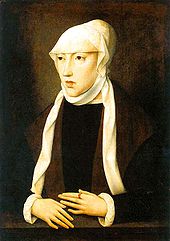 A portrait of Dowager Queen Mary in 1531, by the Master of the Legend of the Magdalen
A portrait of Dowager Queen Mary in 1531, by the Master of the Legend of the Magdalen
On 3 January 1531, Mary's older brother, Holy Roman Emperor Charles V, requested that she assume the regency of the Netherlands. Charles was ruling a vast empire and was constantly in need of reliable family members who could govern his remote territories in his name. Mary reluctantly accepted on Charles' insistence.[9] On 6 October 1537, in Monzón, the Emperor wrote to her:
I am only one and I can't be everywhere; and I must be where I ought to be and where I can, and often enough only where I can be and not where I would like to be; for one can't do more than one can do.[13]Mary served as regent of the Netherlands so well that Charles forced her to retain the post and granted her more powers than their aunt had enjoyed.[14] Unlike her aunt, Mary was deeply unhappy during her tenure as governor and never enjoyed her role. In May 1531, having governed for only four months, Mary told her brother Ferdinand the experience was like having a rope around her neck.[2] While Margaret had been considered truly feminine, flexible, adaptable, humorous and charming, Mary was unyielding and authoritarian. Margaret accomplished her goals using a smile, a joke, or a word of praise, but Mary used cynical and biting comments. Unlike her aunt, Mary was unable to forgive or forget. She recognized this lack of "power as a woman" as her main problem.[15]
Guardianship over nieces
Assuming the regency in the Netherlands meant assuming the guardianship of her nieces, Dorothea and Christina of Denmark, the daughters of her older sister, Queen Isabella of Denmark, who had died in 1526. Upon Isabella's death, the princesses had been cared for by Archduchess Margaret. Charles now relied upon Mary to arrange marriages for them, especially for Dorothea, whom he wanted to place on the Danish throne.[16]
In 1532, Francesco II Sforza, Duke of Milan, proposed a marriage with Christina, who was then 11 years old. Charles agreed to the marriage and allowed its immediate consummation. Mary determinedly opposed this decision, explaining to Charles that Christina was too young for consummation of the marriage. Charles ignored her, but she nevertheless managed to delay the marriage. She first told the Milanese envoy that her niece was ill and then took her to another part of the Netherlands for "serious affairs". Christina was finally married on 28 September 1532, but Mary managed to postpone her departure until 11 March 1533.[16]
Queen Mary receiving Emperor Charles V at her castle in Binche. The castle was the Emperor's gift to his sister, who had it rebuilt under the direction of an architect-sculptor Jacques du Broeucq. It was destroyed by the army of King Henry II of France.
Immediately after Christina's departure, Mary fell ill and requested that she be allowed to resign as governor, but Charles did not allow it. A year later, Dorothea too was married. A few months after Dorothea's departure, the now widowed Christina returned to her aunt's court. King Henry VIII of England immediately proposed marriage to Christina, and Charles urged Mary to negotiate the marriage. She was not in favour of the union, and delayed. Henry was excommunicated in 1539, at which point Charles had to end the negotiations.[16]
Relationship with Charles
The Emperor assured Mary that he had no doubts about her loyalty to the Roman Catholic Church. He had learned that the Queen could not easily be bullied, especially not in matters which affected her personally.[2] Yet, upon leaving the States General in October 1531, Charles gave her a warning, saying that if his parent, wife, child or sibling became a follower of Luther, he would consider them his greatest enemy.[2] Mary was thus forced to suppress Protestantism in the Netherlands, regardless of her own religious tolerance. However, she always strived to enforce her brother's laws on religion as little as possible. She was accused of protecting Protestants on several occasions.[17]
Her determination sometimes caused clashes of wills with Charles. In most matters of patronage, Mary had to defer to Charles, which is why his relations in this area were not much better with Mary than with their aunt Margaret.[2] He often criticized her decisions, which negatively affected their otherwise affectionate relationship.[18]
Riots
"Whoever is in charge of this country should be very sociable with everyone in order to gain the goodwill both of the nobility and the commonality; for this country does not render the obedience which is due to a monarchy, nor is there an oligarchical order nor even that of a republic. And thus a woman, especially if she is a widow, cannot do what should be done." Mary to Charles on the occasion of his abdication as sovereign of the Netherlands. Brussels, 1555.[19] Mary became worried about losing authority and was having trouble with the finances in February 1534. She complained that the budget could not be balanced even during the times of peace. Charles assured her that she was doing her best.[20]
The Queen complained to Charles in August 1537 that the Low Countries were no longer governable and said he should come himself. In fact, Mary handled the crisis quite well and kept a cool head in public.[21] In October, she travelled to the north of France to meet her brother-in-law, King Francis I of France, the second husband of her sister Eleanor. On October 23, they signed a treaty. Francis thereby promised Mary that he would not help those who rebelled against her, while the Queen promised to compensate certain French noblemen who lost their land in the Low Countries during the Italian Wars.[22]
Seeking peace
In 1534, Mary prepared a proposal for a defensive union of all the provinces in her councils. She made the proposal at the States General in Mechelen in July, citing her brother, who had requested the provinces assist each other.[23] The plan had to be given up and, after Mary and Eleanor's failure to negotiate peace between the Empire and France, Mary's letters to Charles began to resemble the theatrical outbursts of their aunt Margaret.[20]
Mary strived for peace in the Netherlands. Charles paid no attention to the problems she was facing as governor and often ignored her warnings.[1] One such incident led to Charles's loss of the city of Metz to France.[24] Mary was forced to wage war against France in 1537 and to deal with the Revolt of Ghent between 1538 and 1540. Mary's appointment as Governor of the Netherlands was renewed on 14 October 1540, after the revolt in Ghent had been subdued.[1]
Resignation
The Queen had to mediate between her brothers in 1555, when Charles decided to abdicate as emperor and leave the government of the Netherlands to his son Philip, despite Ferdinand's objections. When Mary learned of Charles's decision, she informed him that she too would resign. Both Charles and Philip urged her to remain in the post, but she refused. She chronicled the difficulties she had faced due to her gender, the fact that she could not act as she thought she should have because of disagreements with Charles, and her age. Furthermore, she did not wish to accommodate to the ways of her nephew after years of getting used to Charles's demands.[25] The actual reason for Mary's resignation was her numerous disagreements with her nephew.[26] She asked for Charles's permission to leave the Netherlands upon her resignation, fearing that she would be drawn into politics again if she remained.[25]
Charles finally allowed his sister to resign. She formally announced her decision on 24 September 1555 and dismissed her household on 1 October. On 25 October, her authority was transferred to Philip,[25] who, despite his personal dislike of his aunt, tried to convince her to resume the post. After another quarrel with Philip, Mary retired to Turnhout.[27] She remained in the Netherlands one more year.[25]
Life in Castile
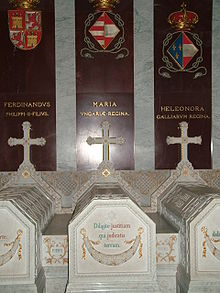 Mary's tomb in El Escorial. Her grandnephew, Ferdinand, Prince of Asturias, and her sister Eleanor are buried next to her. Mary's arms can be seen above her tomb.
Mary's tomb in El Escorial. Her grandnephew, Ferdinand, Prince of Asturias, and her sister Eleanor are buried next to her. Mary's arms can be seen above her tomb.
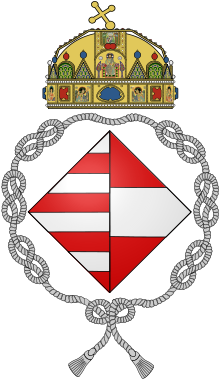 Mary's coat of arms as Dowager Queen of Hungary. She bore the arms of her father impaled with the arms of her husband.
Mary's coat of arms as Dowager Queen of Hungary. She bore the arms of her father impaled with the arms of her husband.
Mary wished to retire to Castile and live with her recently widowed sister Eleanor, near Charles, who had retired. She was afraid of moving to Castile because, although her mentally unstable mother Joanna (who died aged 77 in April 1555) had been sovereign there, Mary had never lived in Castile. She was afraid that Eleanor's death would leave her alone in a country whose customs she did not know. In the end, she decided to move to Castile, while retaining the possibility of moving back to the Netherlands in case she could not adjust to the Castilian customs. Charles, Eleanor, and Mary sailed from Ghent on 15 September 1556.[25]
Although she repeatedly assured her brother that she had no intention of occupying herself with the affairs of state, Mary offered to become adviser to her niece Joan, who was serving as regent for Philip. Joan did not wish to share power and declined her aunt's offer.[28][29]
Mary did not enjoy her retirement for long; Eleanor died in her arms in February 1558.[30] The grief-stricken queen travelled to Charles to ask him for advice about her future. Charles told her that he wanted her to resume regency in the Netherlands, and promised a home and a large income, but Mary declined the offer. Her nephew Philip then urged her advisor to convince her to return. When Charles became ill in August, Mary accepted the offer and decided that she would become governor once again.[31]
In September, Mary was fully prepared to depart for the Netherlands and resume her post when she was informed of Charles's death. Distressed by the death of another sibling, the Queen, who had suffered from a heart disease most of her life, had two heart attacks in October. Both were so severe that her doctors thought that she had died.[32][33] When Joan visited her, Mary was still determined to fulfil the promise she had given to Charles and assume the regency in the Netherlands, but she was weak and feverish.[34] She died only few weeks later, in Cigales on 18 October 1558.[31]
In her last will, Mary left all her possessions to Charles. Since Charles had died, Philip inherited his aunt's property. Shortly before her death, she decided that Philip and Joan should execute her will.[35] She requested that her heart-shaped gold medallion, once worn by her husband, be melted down and the gold distributed to the poor.[36]
Queen Mary was first buried in the Monastery of Saint Benedict in Valladolid. Fifteen years after her death, Philip ordered that the remains be transferred to El Escorial.[35]
Legacy
Mary was a keen collector art, and owned several important masterpieces of Early Netherlandish painting as well as more contemporary works. These included the Deposition of Christ by Rogier van der Weyden, now in the Museo de Prado, and the Arnolfini Portrait by Jan van Eyck, now in the National Gallery, London. Most of the collection passed to the Spanish Royal Collection after her death.[37]
Queen Mary of Hungary was a great patron of music. She supported both sacred and secular music at her court in the Netherlands, where her maître de chappelle was Benedictus Appenzeller. Several elaborate music manuscripts that she commissioned during her governance are preserved in Spain in the monastery of Montserrat.[38]
Ancestry
Ancestors of Mary of Hungary (governor of the Netherlands) 16. Ernest, Duke of Austria 8. Frederick III, Holy Roman Emperor 17. Cymburgis of Masovia 4. Maximilian I, Holy Roman Emperor 18. Edward of Portugal 9. Eleanor of Portugal 19. Eleanor of Aragon 2. Philip I of Castile 20. Philip the Good 10. Charles the Bold 21. Isabella of Portugal 5. Mary, Duchess of Burgundy 22. Charles I, Duke of Bourbon 11. Isabella of Bourbon 23. Agnes of Burgundy 1. Mary of Austria 24. Ferdinand I of Aragon 12. John II of Aragon 25. Eleanor of Alburquerque 6. Ferdinand II of Aragon 26. Fadrique Enríquez de Mendoza 13. Juana Enriquez 27. Merina de Cordova 3. Joanna I of Castile 28. Henry III of Castile 14. John II of Castile 29. Catherine of Lancaster 7. Isabella I of Castile 30. John, Lord of Reguengos de Monsaraz 15. Isabella of Portugal 31. Isabella of Braganza Notes
- ^ Despite her interest in the teachings of Martin Luther, Mary never renounced Roman Catholicism.
- ^ Mary's full title during her tenure as governor of the Netherlands was: Mary, by the Grace of God, Queen of Hungary, of Bohemia, etc., governor of the Netherlands for His Imperial and Catholic Majesty, and his lieutenant.
References
Footnotes
- ^ a b c Jansen, 101.
- ^ a b c d e f g Koenigsberger, 125.
- ^ de Iongh, 16–17.
- ^ a b c d e O'Malley, 178.
- ^ a b c d e f Bietenholz, 399.
- ^ Goss, 132 (Music in the Court Records of Mary of Hungary).
- ^ de Iongh, 72.
- ^ a b c Jansen, 98.
- ^ a b c d O'Malley, 179.
- ^ Earenfight, 50.
- ^ Cruz, 94.
- ^ a b c d e Jansen, 99.
- ^ Koenigsberger, 123.
- ^ Piret, 63.
- ^ Jansen, 102, 104.
- ^ a b c Jansen, 100–101.
- ^ Piret, 80.
- ^ Koenigsberger, 136.
- ^ Koenigsberger, 151.
- ^ a b Koenigsberger, 137.
- ^ Koenigsberger, 144.
- ^ Knecht, 173.
- ^ Koenigsberger, 130.
- ^ Knecht, 215.
- ^ a b c d e Jansen, 103.
- ^ Piret, 161-162.
- ^ Piret, 163.
- ^ Iongh, 282.
- ^ Piret, 167.
- ^ Piret, 166.
- ^ a b Jansen, 104.
- ^ de Iongh, 288.
- ^ Piret, 168.
- ^ de Iongh, 289.
- ^ a b Piret, 171.
- ^ de Iongh, 273–274.
- ^ Wethey, 202.
- ^ Goss, 132–173 (Music in the Court Records of Mary of Hungary).
Bibliography
- Bietenholz, Peter G.; Deutscher, Thomas B. (2003). Contemporaries of Erasmus: a biographical register of the Renaissance and Reformation, Volumes 1-3. University of Toronto Press. ISBN 0802085776.
- Cruz, Anne J.; Suzuki, Mihoko (2009). The Rule of Women in Early Modern Europe. University of Illinois Press. ISBN 0252076168.
- Earenfight, Theresa (2005). Queenship and political power in medieval and early modern Spain. Ashgate Publishing, Ltd. ISBN 075465074X.
- Goss, Glenda (1984). Music in the Court Records of Mary of Hungary. University of North Carolina.
- de Iongh, Jane (1958). Mary of Hungary: second regent of the Netherlands. Norton.
- Jansen, Sharon L. (2002). The monstrous regiment of women: female rulers in early modern Europe. Palgrave Macmillan. ISBN 0312213417.
- Knecht, Robert Jean (2001). The rise and fall of Renaissance France, 1483-1610. Wiley-Blackwell. ISBN 0631227296.
- Koenigsberger, Helmut Georg (2001). Monarchies, states generals and parliaments: the Netherlands in the fifteenth and sixteenth centuries. Cambridge University Press. ISBN 0521803306.
- O'Malley, John W. (1988). Collected Works of Erasmus: Spiritualia. University of Toronto Press. ISBN 0802026567.
- Piret, Etienne (2005). Marie de Hongrie. Jordan. ISBN 293035934X.
- Wethey, Harold (1969). The Paintings of Titian: The portraits. Phaidon.
Further reading
- Brand, Hanno (2007). The dynamics of economic culture in the North Sea and Baltic Region: in the late Middle Ages and early modern period. Uitgeverij Verloren. ISBN 9065508821.
- Goss, Glenda (1975). Benedictus Appenzeller: Maître de la Chappelle to Mary of Hungary and Chansonnier. University of North Carolina.
- Goss, Glenda (1984). Mary of Hungary and Music Patronage (Sixteenth Century Journal). University of North Carolina.
- Réthelyi, Orsolya (2005). Mary of Hungary: the queen and her court, 1521-1531. Budapest History Museum. ISBN 9639340502.
- Sicking, Louis (2004). Neptune and the Netherlands: state, economy, and war at sea in the Renaissance. BRILL. ISBN 9004138501.
- Woodfield, Ian (1988). The Early History of the Viol. Cambridge University Press. ISBN 0521357438.
External links
 Media related to Mary of Habsburg at Wikimedia CommonsMary of Hungary (governor of the Netherlands)House of HabsburgBorn: 15 September 1505 Died: 18 October 1558
Media related to Mary of Habsburg at Wikimedia CommonsMary of Hungary (governor of the Netherlands)House of HabsburgBorn: 15 September 1505 Died: 18 October 1558Royal titles Vacant Title last held byAnne of Foix-CandaleQueen consort of Bohemia
1515–1526Succeeded by
Anne JagiellonQueen consort of Hungary
1515–1526Succeeded by
Isabella Jagiellon
as queen of Eastern HungarySucceeded by
Anne Jagiellon
as queen of Royal HungaryPolitical offices Vacant Title last held byMargaret of AustriaGovernor of the Habsburg Netherlands
1531–1555Succeeded by
Emmanuel Philibert of SavoyInfantas of Aragon 1st Generation Sancha, Countess of Urgell · Urraca · Teresa, Countess of Provence2nd Generation none3rd Generation Isabella · Petronila4th Generation 5th Generation Constance, Holy Roman Empress · Eleanor, Countess of Toulouse · Dulce6th Generation Sancha7th Generation Violant, Queen of Castile · Constance, Lady of Villena · Sancha · Isabella, Queen of France · Maria · Eleanor8th Generation Elizabeth, Queen of Portugal · Yolanda, Duchess of Calabria · Sancha, Queen of Naples* · Isabella* · Blanca of Ayerbe · Teresa, Lady of Fraga9th Generation Maria, Lady of Cameros · Constance, Duchess of Peñafiel · Isabella, Duchess of Austria · Blanca · Violante, Lady of Segorbe · Constance, Queen of Cyprus** · Elisabeth, Duchess of Bavaria** · Catherine** · Margaret, Countess Palatine of the Rhine** · Beatrice, Lady of Marchena · Maria, Countess of Ampurias · Teresa of Jérica · Constanza of Ayerbe · Maria, Laby of Ayerbe10th Generation Constance, Queen of Majorca · Isabella · Eleanor, Queen of Cyprus · Juana, Lady of Villena · Blanca, Countess of Cardona · Eleanor, Queen of Aragon** · Beatrice, Countess Palatine of the Rhine** · Constance** · Euphemia** · Violante** · Blanca, Countess of Ampurias** · Eleonor, Countess of Caltabellotta** · Constance** · Isabella, Marchioness of Montferrat* · Esclaramunda* · Alice, Countess of Ibelin* · Beatrice, Lady of Cocentaina · Ventura, Viscountess of Illa and Canet · Elsa, Lady of Almonacid · Juana, Countess of Carrión11th Generation Constance, Queen of Sicily · Joanna, Countess of Ampurias · Maria · Beatrice · Eleanor, Queen of Castile · Isabella, Countess of Urgell · Isabella, Countess of Cardona · Blanca of Ribagorza · Joanna, Countess of Cardona · Violante, Countess of Prades · Joanna of Prades · Constance of Prades · Eleanor of Prades · Timbor, Viscountess of Cabrera · Eleanor of Ampurias · Maria of Sicily**12th Generation Joanna, Countess of Foix · Yolande, Duchess of Anjou · Eleanor · Antonia · Margaret · Beatrice of Urgell · Eleanor of Urgell · Cecilia, Countess of Modica · Isabella of Urgell · Eleanor of Prades · Isabella of Prades · Joanna, Countess of Prades · Margarida, Queen of Aragon · Timbor of Prades13th Generation Isabella of Urgell, Duchess of Coimbra · Eleanor, Princess of Salerno · Joanna, Countess of Cardona · Catherine of Urgell14th Generation 15th Generation 16th Generation 17th Generation Eleanor, Queen of France · Isabella, Queen of Denmark-Norway · Mary, Queen of Hungary · Catherine, Queen of Portugal*also a princess of Majorca
**also a princess of SicilyAustrian archduchesses by birth 1st generation none2nd generation Archduchess Helena · Kunigunde, Duchess of Bavaria3rd generation 4th generation Eleanor, Queen of France* · Isabella, Queen of Denmark and Norway* · Maria, Queen of Hungary* · Catherine, Queen of Portugal*5th generation Elisabeth, Queen of Poland · Maria, Holy Roman Empress* · Anna, Duchess of Bavaria · Archduchess Isabella* · Maria, Duchess of Jülich-Cleves-Berg · Archduchess Magdalena · Catherine, Queen of Poland · Eleanor, Duchess of Mantua · Archduchess Margaret · Joan, Princess of Portugal* · Barbara, Duchess of Ferrara · Archduchess Ursula · Archduchess Helena · Joanna, Grand Duchess of Tuscany6th generation Anna, Queen of Spain · Elisabeth, Queen of France · Archduchess Maria · Archduchess Maria · Isabella Clara Eugenia, Co-sovereign of the Habsburg Hetherlands* · Archduchess Margaret · Catherine Michelle, Duchess of Savoy* · Archduchess Eleanor · Archduchess Maria* · Archduchess Martha · Archduchess Anna Eleanor · Archduchess Maria · Anna, Holy Roman Empress · Anna, Queen of Poland · Maria Christina, Princess of Transilvania · Archduchess Catherine Renata · Archduchess Elisabeth · Archduchess Gregoria Maximiliana · Archduchess Eleanor · Margaret, Queen of Spain · Constance, Queen of Poland · Maria Maddalena, Grand Duchess of Tuscany7th generation Archduchess Christine · Anna, Queen of France* · Archduchess Maria · Maria Anna, Holy Roman Empress* · Archduchess Anna Mauritia · Maria Anna, Electress of Bavaria · Archduchess Margarita Francisca* · Cecilia Renata, Queen of Poland · Archduchess Maria Eleanor · Isabella Clara, Duchess of Mantua · Maria Leopoldine, Holy Roman Empress8th generation Archduchess Maria Margarita* · Archduchess Margarita Maria Catalina* · Archduchess Maria Eugenia* · Archduchess Isabella Maria Teresa* · Maria Anna, Queen of Spain · Archduchess Maria Anna Antonia* · Maria Theresa, Queen of France* · Archduchess Maria · Margarita Teresa, Holy Roman Empress* · Archduchess Theresia Maria Josepha · Eleanor, Queen of Poland, Duchess of Lorraine · Claudia Felicitas, Holy Roman Empress · Maria Anna Josepha, Electoral Princess of the Palatinate · Archduchess Maria Ambrosia de la Concepción* · Archduchess Maria Magdalena9th generation Maria Antonia, Electress of Bavaria · Archduchess Maria Anna Antonia · Archduchess Anna Maria · Archduchess Maria Josepha · Archduchess Christina · Archduchess Maria Elisabeth · Maria Anna, Queen of Portugal · Archduchess Maria Theresa · Archduchess Maria Josepha · Archduchess Maria Magdalena · Archduchess Maria Margaretha10th generation Maria Josepha, Queen of Poland · Maria Amalia, Holy Roman Empress · Maria Theresa · Maria Anna, Princess Charles Alexander of Lorraine · Archduchess Maria Amalia11th generation Archduchess Maria Elisabeth** · Archduchess Maria Anna** · Archduchess Maria Carolina** · Maria Christina, Duchess of Teschen** · Archduchess Maria Elisabeth** · Maria Amalia, Duchess of Parma** · Archduchess Maria Carolina** · Archduchess Johanna** · Archduchess Maria Josepha** · Maria Carolina, Queen of Naples** · Marie Antonia, Queen of France**12th generation Archduchess Maria Theresa · Archduchess Marie Christine · Maria Theresia, Queen of Saxony** · Archduchess Maria Anna** · Maria Theresa, Queen of Sardinia*** · Archduchess Maria Josepha*** · Maria Leopoldine, Electress of Bavaria*** · Maria Clementina, Duchess of Calabria** · Archduchess Maria Amalia** · Archduchess Maria Antonia*** · Maria Ludovika, Empress of Austria***13th generation Archduchess Ludovika Elisabeth · Marie Louise, Empress of the French · Archduchess Carolina Ferdinande** · Archduchess Maria Caroline · Archduchess Caroline Ludovika · Maria Leopoldina, Empress of Brazil · Clementina, Princess of Salerno · Archduchess Maria Luisa** · Archduchess Alexandrine · Maria Theresa, Queen of Sardinia** · Marie Caroline, Crown Princess of Saxony · Archduchess Maria Anna · Archduchess Amalia Theresa · Maria Theresa, Queen of the Two Sicilies · Maria Theresa, Countess of Chambord*** · Archduchess Hermine · Archduchess Franziska · Archduchess Maria Caroline · Adelaide, Queen of Sardinia · Maria Beatrix, Countess of Montizón*** · Archduchess Maria Caroline · Archduchess Elisabeth Franziska · Marie Henriette, Queen of the Belgians14th generation Archduchess Maria Anna · Archduchess Maria Carolina** · Auguste Ferdinande, Princess Luitpold of Bavaria** · Archduchess Maria Maximiliana** · Maria Isabella, Countess of Trapani** · Archduchess Maria Theresia** · Archduchess Maria Cristina** · Archduchess Maria Anna** · Maria Theresa, Duchess Philipp of Württemberg · Archduchess Mathilda · Maria Christina, Queen of Spain · Archduchess Maria Eleonora · Archduchess Elisabeth · Maria Dorothea, Duchess of Orléans · Margaretha Klementine, Princess of Thurn and Taxis · Archduchess Elisabeth Henriette · Archduchess Klotilde · Maria Theresa, Queen of Bavaria***15th generation Archduchess Sophie · Gisela, Princess Leopold of Bavaria · Archduchess Marie Valerie · Margarete Sophie, Duchess of Württemberg · Archduchess Maria Annunziata · Elisabeth, Princess Aloys of Liechtenstein · Archduchess Maria Antonietta** · Luise, Crown Princess of Saxony** · Anna, Princess of Hohenlohe-Bartenstein** · Archduchess Margareta** · Archduchess Germana** · Archduchess Agnes** · Archduchess Maria Theresa** · Karoline Marie, Princess Leopold of Saxe-Coburg and Gotha** · Archduchess Maria Antonietta** · Maria Immaculata, Duchess of Württemberg** · Archduchess Henriette** · Maria Christina, Princess Emmanuel of Salm-Salm · Maria Anna, Princess Elias of Bourbon Parma · Maria Henrietta, Princess of Hohenlohe-Waldenburg-Schillingsfürst · Archduchess Natalie · Archduchess Stephanie · Archduchess Gabrielle · Isabella, Princess Georg of Bavaria · Alice, Baroness Waldbott of Bassenheim · Archduchess Eleonora, Mrs. Alfons von Kloss · Renata, Princess Hieronymus Radziwill · Mechthildis, Princess Olgierd Czartoryski · Archduchess Gisele · Archduchess Sophie · Archduchess Magdalena16th generation Elisabeth Marie, Princess of Windisch-Graetz · Helena, Duchess Philipp of Württemberg** · Rosa, Duchess of Württemberg** · Archduchess Dolores** · Maria Inmaculada, Nobile Inigo Neri Sereneri** · Margarita, Marchioness Taliani di Marchio** · Princess Maria Antonia, Mrs. Luis Pérez** · Archduchess Assunta, Mrs. Joseph Hopfinger** · Elisabeth, Countess of Waldburg-Zeil** · Hedwig, Countess of Stolberg-Stolberg** · Gertrud, Countess of Waldburg-Zeil-Trauchburg** · Archduchess Maria Elisabeth** · Archduchess Agnes** · Archduchess Margarethe, Mrs. Alexander Cech · Ilona, Duchess of Mecklenburg · Archduchess Anna Theresia · Archduchess Maria Kynga, Mrs. Joachim Krist17th generation Archduchess Adelheid · Charlotte, Duchess of Mecklenburg · Elisabeth, Princess Heinrich of Liechtenstein · Elisabeth, Edle Hubert von Braun** · Alice, Baroness Vittorio Manno** · Marie Antoinette, Baroness of Proff in Irnich** · Archduchess Marie Christine** · Archduchess Walburga, Mrs. Carlos Tasso** · Archduchess Verena** · Archduchess Katharina, Mrs. Roland Huber** · Agnes, Baroness Peter of Fürstenberg** · Maria Ileana, Countess Adam Kottulinski** · Alexandra, Baroness Viktor of Baillou** · Maria Magdalena, Baroness of Holzhausen** · Archduchess Elisabeth, Mrs. Friedrich Sandhofer** · Agnes, Princess Karl Alfred of Liechtenstein** · Archduchess Maria Margaretha** · Archduchess Ludovica** · Archduchess Allix** · Josepha, Countess Clemens of Waldstein-Wartenberg** · Valerie, Margravine of Baden** · Alberta, Baroness Alexander of Kottwitz-Erdödy** · Theresa, Princess Rasso of Bavaria** · Maria Inmakulata, Countess Reinhart of Hoensbroech** · Archduchess Monika, Mrs. Charles de Rambures · Archduchess Marie Christine, Mrs. Raymond van der Meide · Archduchess Maria, Mrs. Wilhelm de Witt · Margherita, Countess Benedikt of Piatti18th generation Andrea, Hereditary Countess of Neipperg · Monika, Duchess of Maqueda · Michaela, Countess Hubertus of Kageneck · Archduchess Gabriela, Mrs. Christian Meister · Walburga, Countess Archibald Douglas · Maria Beatrix, Countess Riprand of Arco-Zinneberg*** · Isabella, Countess Andrea Czarnocki-Lucheschi*** · Maria del Pilar, Edle Vollrad-Joachim von Poschinger · Kinga, Baroness Wolfgang of Erffa · Archduchess Marie Adelheid, Mrs. Jaime Corcuerra · Archduchess Viridis, Mrs. Karl Dunning-Gribble · Archduchess Alexandra, Mrs. Héctor Riesle · Maria Constanza, Princess of Auersperg-Trautson · Maria Anna, Princess Peter Galitzine · Catharina, Countess Maximiliano Secco d'Aragona · Archduchess Elisabeth, Mrs. James Litchfield · Sophie, Princess of Windisch-Grätz · Archduchess Marie Christine, Mrs. Clemens Guggenberg · Archduchess Marie Bernadette, Mrs. Rupert Wolff** · Archduchess Katharina, Mrs. Niall Brooks** · Archduchess Alicia** · Archduchess Maria Christina** · Archduchess Margaretha, Mrs. Andreas Baumgartner** · Archduchess Marie Valerie, Mrs. Martin Josef Wagner** · Archduchess Hedwig** · Archduchess Veronika** · Archduchess Johanna · Archduchess Elisabeth · Archduchess Celina · Archduchess Maria Floriana · Archduchess Sofía · Archduchess Anna Carolina · Archduchess Theresa · Archduchess Sophie · Archduchess Ladislaya19th generation Archduchess Eleonore · Archduchess Gloria · Archduchess Sophie · Archduchess Hilda · Archduchess Maria Laura*** · Archduchess Luisa Maria*** · Archduchess Laetitia Maria*** · Archduchess Sophia · Archduchess Maria Theresa · Archduchess Margherite · Archduchess Priscilla · Archduchess Marie des Neiges · Marie Christine, Countess Rodolphe of Limburg-Stirum · Archduchess Gabriella · Archduchess Antonia · Archduchess Isabelle · Archduchess Carlotta · Archduchess Paulina · Archduchess Lara · Archduchess Katharina · Archduchess Tatyana** · Archduchess Anabella** · Archduchess Tara** · Archduchess Amaya20th generation Archduchess Zita · Archduchess Anežka*also an infanta of Spain
**also a princess of Tuscany
***also a princess of ModenaHungarian queens Gisela of Bavaria (1000–1038) · Anastasia of Kiev (1046–1060) · Richeza of Poland (1060–1063) · Judith of Swabia (1063–1074) · Synadene (1074–1077) · Adelaide of Rheinfelden (1077–1090) · Felicia of Sicily (1097–1102) · Euphemia of Kiev (1112–1113) · Cristiana of Capua (1120–1121) · Adelaide of Riedenburg (1121–1131) · Helena of Rascia (1131–1141) · Euphrosyne of Kiev (1146–1162) · Yaroslavna of Halych (1167–1168) · Agnes of Babenberg (1168–1172) · Maria Komnene (1163–1165) · Agnes of Antioch (1172–1184) · Margaret of France (1186–1196) · Constance of Aragon (1198–1204) · Gertrude of Merania (1203–1213) · Yolanda de Courtenay (1215–1233) · Beatrice d'Este (1234–1235) · Maria Laskarina (1235–1270) · Elizabeth the Cuman (1270–1272) · Elizabeth of Sicily (1269–1290) · Fenenna of Kuyavia (1290–1295) · Agnes of Habsburg (1296–1301) · Viola Elisabeth of Cieszyn (1305–1306) · Maria of Bytom (1306–1317) · Beatrice of Luxembourg (1318–1319) · Elisabeth of Poland (1320–1342) · Margaret of Bohemia (1342–1349) · Elizabeth of Bosnia (1353–1382) · Margaret of Durazzo (1385–1386) · Barbara of Cilli (1405–1437) · Elizabeth of Luxembourg (1437–1442) · Catherine of Poděbrady (1461–1464) · Beatrice of Naples (1476–1490) · Barbara of Brandenburg (1490–1491) · Beatrice of Naples (1491–1500) · Anne of Foix-Candale (1502–1506) · Maria of Austria (1515–1526) · Isabella Jagiellon (1539–1540) · Anne Jagiellon (1526–1547) · Maria of Austria (1563–1576) · Anna of Tyrol (1608–1618) · Eleonora Gonzaga (1622–1625) · Maria Anna of Spain (1631–1646) · Maria Leopoldine of Austria (1648–1649) · Eleonora Gonzaga (1651–1657) · Margaret Theresa of Spain (1666–1673) · Claudia Felicitas of Austria (1673–1676) · Eleonor Magdalene of Neuburg (1676–1705) · Wilhelmine Amalia of Brunswick-Lüneburg (1699–1711) · Elisabeth Christine of Brunswick-Wolfenbüttel (1711–1740) · Maria Luisa of Spain (1790–1792) · Maria Theresa of Naples and Sicily (1792–1807) · Maria Ludovika of Austria-Este (1808–1816) · Caroline Augusta of Bavaria (1816–1830) · Maria Anna of Savoy (1831–1848) · Elisabeth of Bavaria (1854–1898) · Zita of Bourbon-Parma (1916–1918)Categories:- Hungarian queens consort
- 1505 births
- 1558 deaths
- House of Habsburg
- Bohemian queens consort
- Governors of the Habsburg Netherlands
- Female regents
- Archduchesses of Austria
- Aragonese infantas
- Castilian infantas
- Burials in the Pantheon of Infantes at El Escorial
Wikimedia Foundation. 2010.

